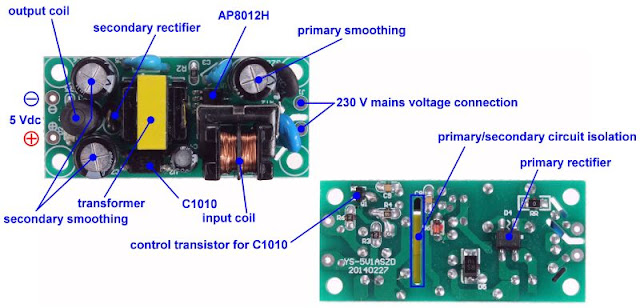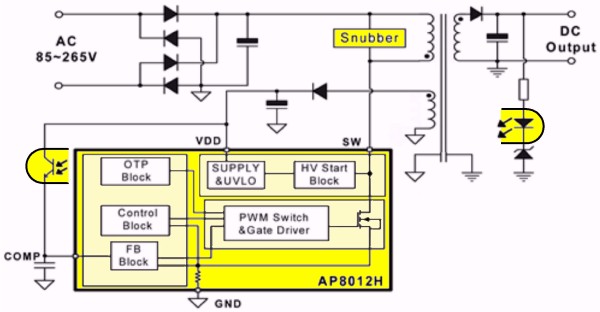Introduction to the YS-5V1ASZD
A 1 A power supply on a very small PCB
On a PCB of barely five by two and a half centimetres is the complete electronics that derives from the 230 V mains voltage a well stabilized and relatively ripple-free DC voltage of 5 V and this at a maximum current of 1 A. The PCB is offered at a unit price of € 2.25. When buying ten, the price even drops to € 1.72.
 |
| The YS-5V1ASZD module delivers 5 Vdc at 1 A. (© Banggood) |
It is of course clear that this performance is only possible by using a switched power supply that works according to the pulse width modulation principle (PWM). In the picture below we have shown the top and bottom of the PCB. As you can see, the separation between the primary 230 V circuit and the secondary 5 Vdc circuit has been confirmed by milling a slot under the transformer, which divides the PCB almost in two.

The necessary feedback from the secondary circuit to the primary circuit is provided by an optical coupler C1010 from Cosmo. Chipown's AP8012H is responsible for switching the rectified 230 V mains voltage at 50 kHz. Both primary and secondary LC circuits are present that provide the necessary, but often forgotten, HF interference suppression.
 |
| The electronics on both sides of the PCB. (© 2019 Jos Verstraten) |
 |
| The basic wiring diagram of the YS-5V1ASZD. (© Chipown) |
According to the manufacturer, the YS-5V1ASZD module fulfils the following technical data:
- Input voltage: 85 Vac ~ 265 Vac
- Input current at 1 A output current: 0.027 A at 220 V
- Output voltage: 4.80 Vdc ~ 5.2 Vdc
- Output current: 1.000 mA max.
- Efficiency: 80 % typical
As is unfortunately often the case, no data are given on the noise, ripple and stabilization of the output voltage.
The YS-5V1ASZD on the test bench
Test conditions
The 5 V output of the module was terminated with a resistor of 1 kΩ and an electrolytic capacitor of 470 μF. The output was connected to an adjustable electronic load.
The stability of the output voltage
The electronic load was increased in steps of 200 mA from 0 mA to 2 A. The impressive results are summarized in the table below. With a load of 1 A, the output voltage had dropped only 10 mV. This gives an excellent value of only 10 mΩ for the internal resistance of the power supply module.
 |
| The stability test of the YS-5V1ASZD. (© 2019 Jos Verstraten) |
The output of switching power supplies is always more or less affected by a residue of the switching frequency. With the YS-5V1ASZD this is very little, see the oscillogram below, recorded at a load current of 1 A. According to the oscilloscope, the peak to peak value of the residue at full load is only 17.2 mV. You also see the switching frequency of exactly 50 kHz.
 |
| The residue on the output voltage at full load. (© 2019 Jos Verstraten) |
At no load, the module primarily consumes a current of 5 mA, which at a mains voltage of 221.7 V corresponds to a power consumption of 1.1 W. At a load current of 1 A, the primary current increases to 25 mA, resulting in a power consumption of 5.54 W. The efficiency is therefore 4.97 W (out) divided by 5.54 W (in) equals 89.7 %, better than the specifications state.

The thermal characteristics
The component density on the PCB is extremely high. There is therefore a chance of a large warming-up of the parts after long use at full load. In the picture below we have summarized our measurement data. The temperatures were measured with an extremely small thermocouple, so with little thermal mass, after the PCB was loaded with 1 A for one hour. As it turns out, the measured temperatures are not that bad. What does worry us is that the output coil had the highest temperature: 85.4 °C. Next to that coil are the two smoothing capacitors which of course will heat up because of this heat source. Whether these parts are really happy with this in the long run is questionable.
 |
| The temperatures on the PCB after one hour of full load. (© 2019 Jos Verstraten) |
Our opinion on the YS-5V1ASZD
If you design a circuit powered exclusively by 5 V you can, in our opinion, entrust the power supply to a YS-5V1ASZD. It is not very likely that you yourself design a power supply that has better specifications than the YS-5V1ASZD.

5V/1A AC-DC Power Supply Stepdown Module

